Clay vessels make perfect seed preservation centers because they're nature's moisture and temperature regulators. You'll find their microscopic pore network controls dampness while maintaining optimal humidity levels of 10% or less for seed storage. The clay's unique thermal properties store 3-4 times more heat than metals, creating a stable environment that protects your seeds from temperature fluctuations. These vessels act as natural barriers against pests and environmental threats while providing ideal conditions for long-term seed viability. With germination success rates of 70% or higher, clay's time-tested effectiveness combines ancient wisdom with proven scientific benefits. There's much more to discover about this remarkable preservation method.
Clay's Natural Moisture Control Properties
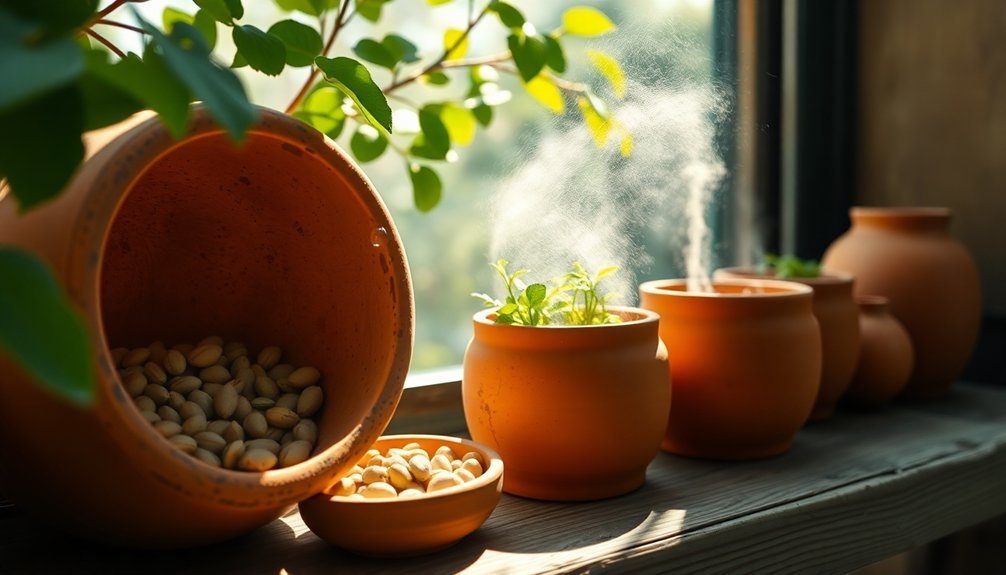
Many clay varieties possess remarkable moisture control properties that make them ideal for seed preservation. When you use clay vessels for storing seeds, you're taking advantage of their microscopic pore network and layered structure, which work together to regulate moisture effectively. The vessels undergo acid treatment processes to enhance their adsorption capabilities.
These pores are precisely sized to trap water molecules while maintaining proper airflow, preventing your seeds from becoming too damp or too dry. The clay's hygroscopic nature means it's constantly working to maintain optimal moisture levels.
You'll find it naturally attracts and bonds with water molecules at a molecular level, which helps keep your seeds at a suitable moisture content of 10% or less. This process is particularly effective in high-humidity conditions, where the clay can absorb up to 25% of its weight in water vapor.
What's even better is that you're using an environmentally friendly solution. Clay vessels are chemical-free, biodegradable, and completely safe for seed storage.
They maintain their structural integrity even when they're fully saturated with moisture, and you can reuse them multiple times by simply reactivating them through heat exposure at temperatures between 120°C and 200°C.
Ancient Wisdom Meets Modern Science
Three ancient preservation techniques have found scientific validation in modern seed storage practices. You'll find that traditional clay and wood ash desiccant beads rival modern alternatives like zeolite in effectiveness. Scientific tests confirm that these age-old materials can maintain their moisture-removing properties through multiple use cycles, making them both sustainable and reliable.
| Ancient Method | Modern Validation | Current Application |
|---|---|---|
| Clay Beads | Moisture removal tests | Comparable to zeolite |
| Wood Ash | Multiple cycle testing | Reusable desiccant |
| Sealed Vessels | Controlled studies | Enhanced with plastic liners |
| Natural Sealing | Airtight measurements | Combined with modern containers |
| Mixed Materials | Laboratory analysis | Integration with new technologies |
You can now combine these time-tested techniques with modern improvements, such as plastic liners and airtight containers. The traditional practice of using clay vessels has proven particularly effective in humid environments, where ECHO's research demonstrates consistent moisture control. When you're working with clay beads, you'll notice they're adaptable to various container types, from traditional clay pots to modern polyethylene bags, making them an accessible solution for both small-scale farmers and community seed banks. The wood-burning cookstoves provide a sustainable source of ash for creating these effective desiccants in rural communities.
Preparing Your Clay Storage System
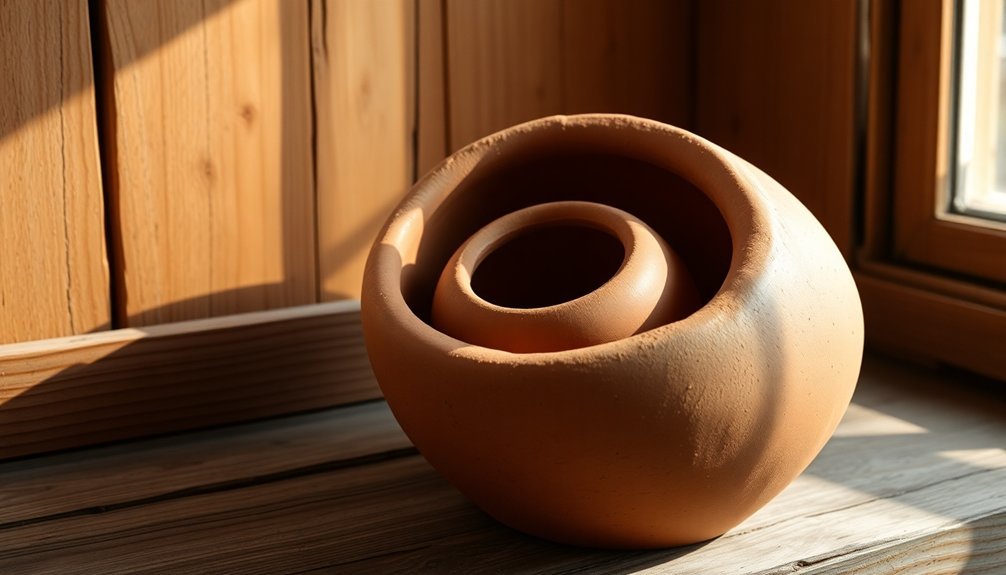
Through proper preparation, your clay storage system can effectively preserve seeds for months or even years.
You'll want to start with high-quality potter's clay or red volcanic clay, making certain it's finely ground and free from any debris or organic matter. If you're using moist clay, you can slice it into smaller pieces to control moisture levels during preparation.
To create your storage system, combine the clay with soil and seeds in a 5:1:1 ratio. Aim for an amount that yields 1-inch diameter balls for optimal results. You'll need to gradually add water while kneading the mixture until it reaches a workable consistency, similar to modeling clay.
Make sure you're distributing the seeds and soil evenly throughout the mixture to guarantee proper preservation.
Form your clay mixture into one-inch balls or your preferred shapes, placing them in egg cartons for the drying process. Let them cure for at least 24 hours in a sunlit area or garden shed, checking periodically for proper drying.
Once dried, store your clay vessels in a protected area away from moisture. When you're ready to use them, place them in well-lit areas with disturbed soil and provide adequate water for germination.
Seed Longevity Through Clay Protection
Protected within clay vessels, seeds can maintain their viability for extended periods while staying safe from environmental threats. You'll find that clay's natural properties create an ideal microclimate that shields your seeds from temperature fluctuations, moisture changes, and unwanted predators.
The clay's structure acts as a physical barrier, preventing birds, insects, and other animals from accessing your precious seeds.
When you store seeds in clay vessels, you're taking advantage of clay's remarkable moisture-retention capabilities. The material maintains consistent humidity levels, preventing your seeds from drying out or becoming too damp. This balance is essential for preserving seed viability and preventing premature germination.
You'll also benefit from clay's ability to regulate temperature. The material provides insulation against extreme heat and cold, protecting your seeds from temperature-related stress.
When you combine clay storage with proper composting materials, you're creating an environment rich in nutrients that'll support your seeds once they're ready for planting. The clay's durability guarantees your seeds remain protected until you're ready to use them, while its natural composition helps neutralize soil acidity and promotes healthy germination conditions.
Cost-Effective Local Resource Solutions
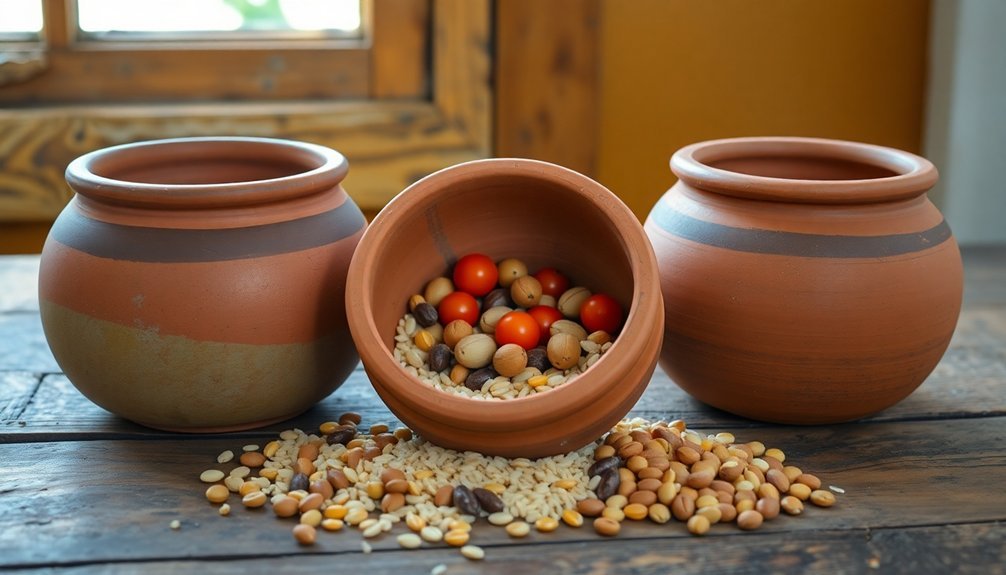
Building upon clay's natural protective qualities, you'll find that the materials needed for seed preservation are remarkably accessible and budget-friendly.
Clay and wood ash are readily available on most farmsteads, costing you nothing but the time to collect and process them. You can easily separate natural clay from other soil types due to its lighter weight, while wood ash comes as a free byproduct from your cooking stove.
The cost-effectiveness of this preservation method extends beyond the initial setup.
You'll appreciate these key benefits:
- Clay beads can be reused at least five times, reducing the need for frequent replacements
- Local blacksmiths or homemade forges can handle the heating process
- Traditional containers like tin cans and glass bottles work perfectly for storage
- You won't need to purchase expensive modern alternatives
- Reactivation through heating keeps maintenance costs minimal
Temperature Regulation Benefits
When you store seeds in clay vessels, you'll benefit from their natural ability to maintain consistently cool temperatures in line with the ideal 0-5°C range for seed preservation.
Clay's porous structure allows it to absorb excess heat during warm periods and release it slowly during cooler times, creating a more stable environment for your stored seeds.
Your seeds will experience less temperature fluctuation in clay containers compared to other materials, which helps reduce their respiration rate and prevents premature deterioration of their essential nutrients.
Natural Cooling Properties
Through their remarkable evaporative cooling process, clay vessels naturally maintain perfect temperatures for seed preservation. As water seeps through the porous clay walls and evaporates on the exterior surface, you'll notice a consistent cooling effect that can lower temperatures by up to 10°C below the surrounding environment.
This natural mechanism creates an excellent environment that won't over-cool your seeds like conventional refrigeration might.
You'll find these vessels particularly effective due to their unique cooling properties:
- Water evaporation through the clay walls creates a natural temperature regulation system
- The cooling process generates a humidity-balanced environment, perfect for seed storage
- Temperature reduction occurs gradually, preventing sudden changes that could harm seeds
- The cooling effect remains consistent as long as there's proper ventilation
- You won't need electricity, making it an energy-efficient preservation method
The vessel's ability to maintain steady temperatures while creating a properly humidified environment makes it a prime choice for seed storage.
Unlike artificial cooling methods, you'll get a perfectly balanced environment that works continuously without the risk of excessive cooling or temperature fluctuations that could compromise seed viability.
Clay's Heat Absorption Capacity
The remarkable heat absorption capacity of clay stands as another powerful benefit alongside its natural cooling properties. You'll find that clay can store three to four times more heat than common metals like iron or copper, thanks to its impressive specific heat rating of 0.33. This means your seeds receive superior temperature stability over extended periods.
When you're preserving seeds, clay's gradual heat distribution becomes vital. It absorbs heat during warmer periods and releases it slowly when temperatures drop, creating a natural thermostat effect. The ideal humidity level of 9.2% in clay vessels guarantees maximum heat conductivity while maintaining structural integrity.
| Property | Clay | Impact on Seeds |
|---|---|---|
| Heat Storage | 3-4x more than metals | Consistent temperature |
| Heat Release | Gradual distribution | Prevents thermal shock |
| Temperature Control | Natural regulation | Extended preservation |
You'll notice that clay's thermal properties work together to protect your seeds from extreme temperature fluctuations. This natural temperature regulation mimics the conditions seeds would experience in their native soil environment, which is essential for maintaining seed viability and preventing premature germination or deterioration.
Sustainable Storage Practices
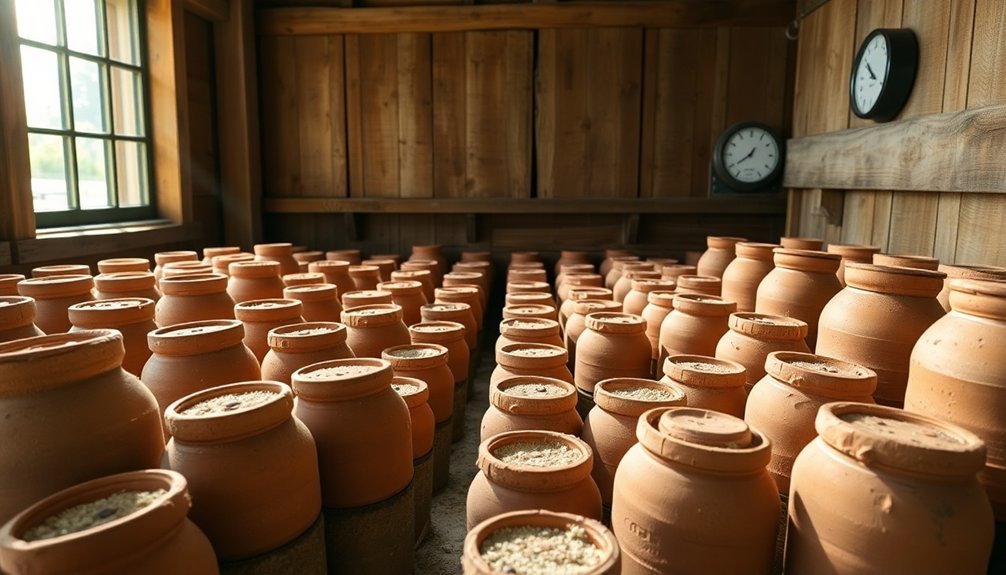
You'll find that processing clay for seed storage vessels creates minimal environmental impact, as the raw materials can be sourced locally and fired using traditional methods.
Your zero-waste storage approach becomes possible when you combine clay vessels with natural sealing materials like wood ash and mud, eliminating the need for synthetic containers.
You can further enhance sustainability by reusing these vessels across multiple seasons and recycling damaged pots back into the soil, creating a truly circular storage solution.
Eco-Friendly Clay Processing
Clay's eco-friendly processing methods have revolutionized sustainable seed storage practices while maintaining pottery's time-honored traditions.
When you're creating clay vessels for seed preservation, you'll find that recycling clay considerably reduces waste while preserving resources. The process involves breaking down used clay into a slurry, filtering out impurities, and settling the mixture to create clean, reusable material.
The eco-friendly processing approach offers several key benefits for your seed storage needs:
- You'll minimize water waste through efficient recycling and filtering techniques
- You can guarantee uniform consistency through manual wedging without machinery
- Your costs decrease considerably by reusing materials instead of buying new clay
- You'll create cleaner, more sustainable vessels through thorough filtration
- You can support local resource utilization, reducing transportation emissions
Zero-Waste Storage Solutions
Sustainable storage practices have stepped up to meet modern conservation needs while eliminating waste. When you're looking to store seeds effectively, clay vessels offer a zero-waste solution that naturally controls humidity and creates ideal preservation conditions.
You'll find that these pots can be sealed with mud or clay to maintain airtight conditions, ensuring your seeds remain viable for extended periods.
To maximize your storage efficiency, you can complement clay pots with other eco-friendly options. Consider using glass containers for visible seed organization, as they're endlessly recyclable and provide clear content identification.
Stainless steel containers offer another sustainable choice, providing airtight seals and stackability for space-efficient storage.
For smaller quantities or temporary storage, you'll benefit from reusable silicone covers and cloth bags. These alternatives eliminate the need for single-use plastics while helping control moisture levels.
The cloth bags are particularly useful when collecting seeds from bulk sources, and they can double as filters for separating seed debris.
Clay Vessel Maintenance Tips
Caring for clay vessels requires consistent attention to detail and proper maintenance practices. When maintaining your clay vessels for seed storage, you'll need to follow specific cleaning and handling procedures to guarantee their longevity and effectiveness.
Start by seasoning your vessel properly – soak it in water overnight, then apply a thin layer of coconut oil or ghee. You'll want to clean it after each use with mild soap and a soft sponge, avoiding harsh chemicals that the clay might absorb. Never use steel scrubbers, as they'll damage the surface.
Here are essential maintenance tips to keep your clay vessels in prime condition:
- Let vessels dry completely before storing to prevent mold growth
- Use low to medium heat only, avoiding sudden temperature changes
- Clean with natural solutions like salt and baking soda for stubborn residue
- Store in well-ventilated areas with proper spacing between vessels
- Handle with care using protective cloth padding when moving or stacking
Remember to inspect your vessels regularly for cracks or damage. If they become wet during storage, dry them under sunlight or use medium heat on your stove to remove moisture completely.
Enhancing Seed Germination Success Rates
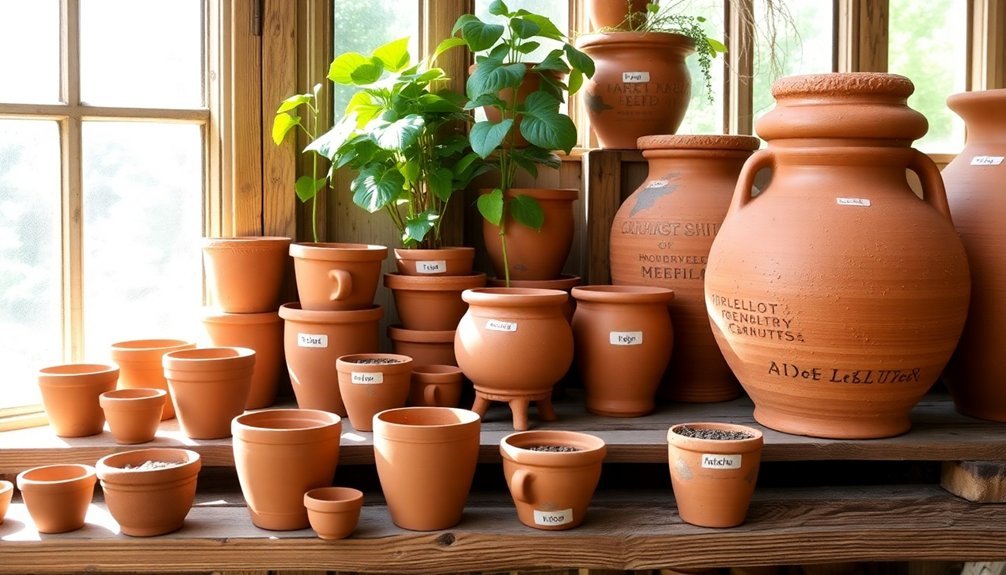
Successful seed germination begins with proper storage techniques and careful attention to moisture control. You'll achieve higher germination rates of 70% or more when you store seeds in airtight containers with effective desiccants like clay beads. These beads, made from clay and wood ash, work particularly well in sealed environments where they can consistently absorb excess moisture.
You can enhance your seed preservation by choosing the right container material. While clay vessels are naturally porous, you'll improve their effectiveness by lining them with plastic or applying latex paint. For even better results, consider using non-porous alternatives like tin cans, glass bottles, or polyethylene bags. These containers, when properly sealed, maintain lower humidity levels and protect against storage fungi.
To maximize germination success, fill your containers completely to eliminate dead air space. You don't need fancy equipment – local materials work well when used correctly.
Whether you're using traditional clay pots or modern alternatives, combining them with clay beads will help maintain seed viability. Remember, even partially sealed containers show improved germination rates when you include desiccants in your storage system.
Frequently Asked Questions
Can Clay Vessels Be Used to Store Different Types of Seeds Together?
You can store different seed types together in clay vessels as long as they have similar moisture requirements. Mix them with neem leaves for pest control, and guarantee they're properly dried to 8-10% moisture content.
How Often Should Clay Beads Be Replaced in Storage Containers?
You'll need to replace clay beads after about five uses, but you can reactivate them through heating at 120-200°C for 8-10 minutes. Regular monitoring helps guarantee they're still absorbing moisture effectively.
What Happens if Wood Ash Is Mixed With Clay During Preparation?
When you mix wood ash with clay, you'll get a stronger, more heat-resistant material. It improves thermal shock resistance and creates better desiccant properties. The ash acts as a flux, lowering the firing temperature needed.
Do Painted Clay Vessels Maintain the Same Moisture-Absorbing Properties?
No, paint won't greatly affect your clay vessel's moisture absorption. While it adds a decorative layer, it's too thin to seal the pores completely. You'll still maintain most of the clay's natural moisture-absorbing properties.
Can Cracked Clay Vessels Be Repaired for Continued Seed Storage Use?
You can't effectively repair cracked clay vessels for seed storage. Once fired clay pots crack, they won't maintain proper moisture control. It's best to transfer your seeds to an undamaged container for safe preservation.
In Summary
You'll find clay vessels offer an elegant, time-tested solution for seed preservation that's both practical and sustainable. They'll serve your storage needs while honoring ancient agricultural wisdom. By maintaining proper moisture levels and temperature control, your seeds will remain viable longer. Whether you're a small-scale gardener or serious seed saver, clay vessels provide an affordable, effective method that'll enhance your preservation efforts.

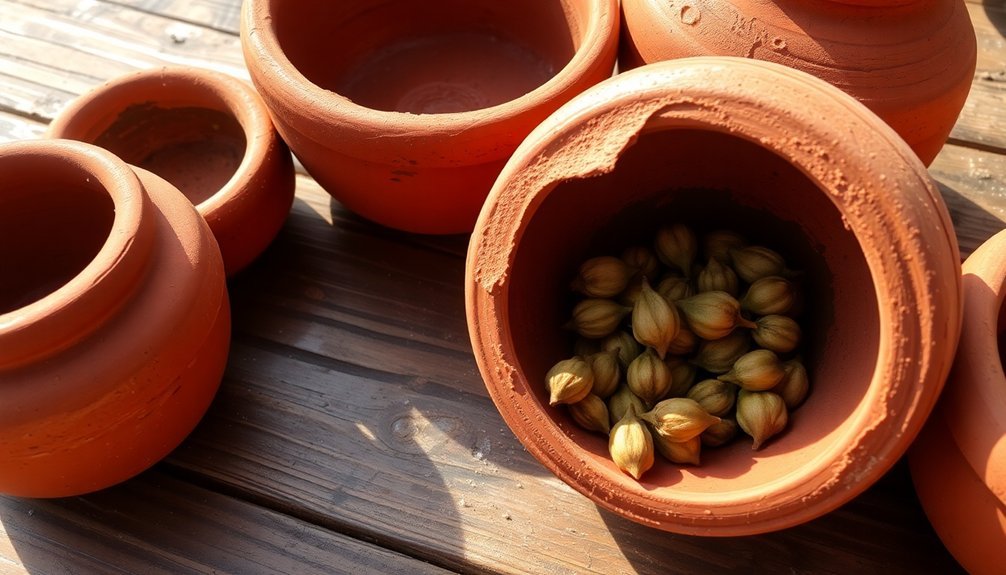



Leave a Reply